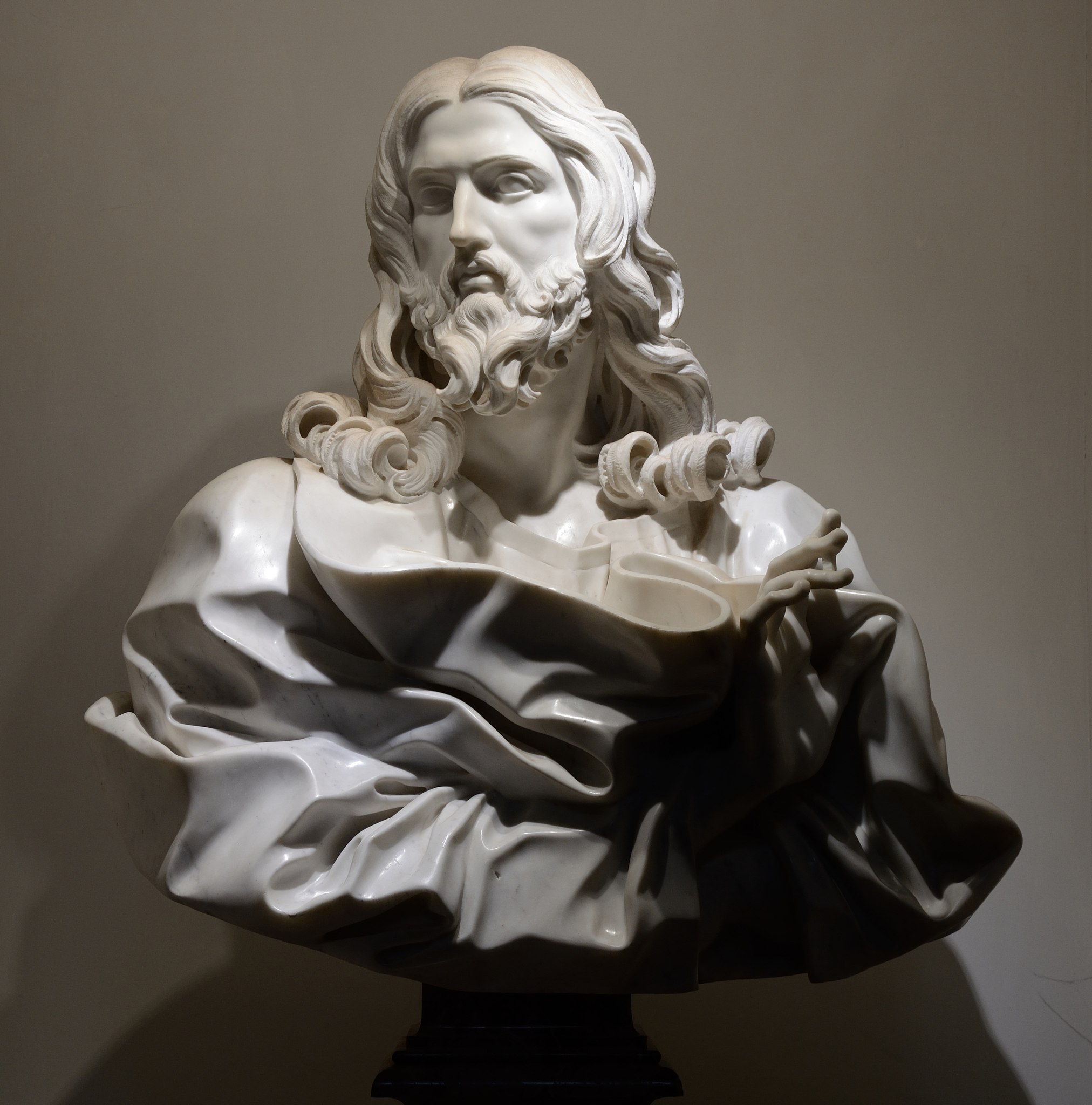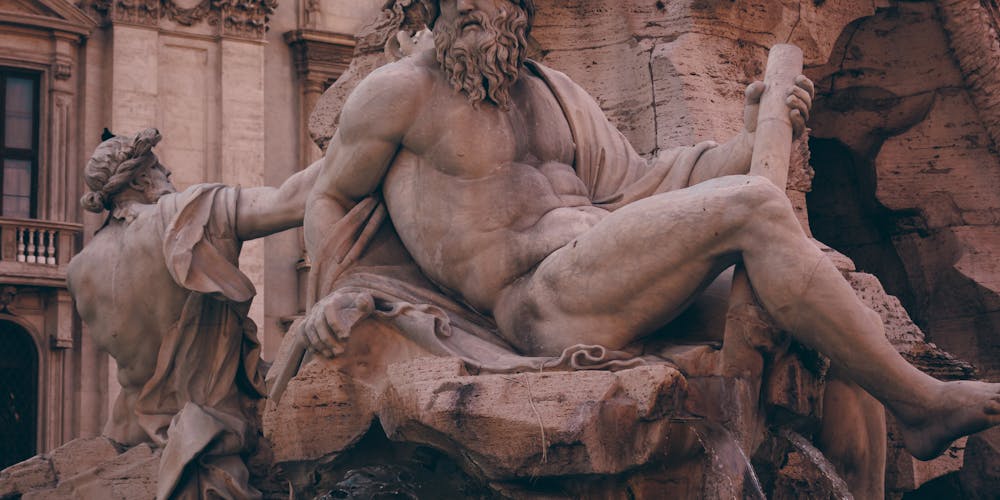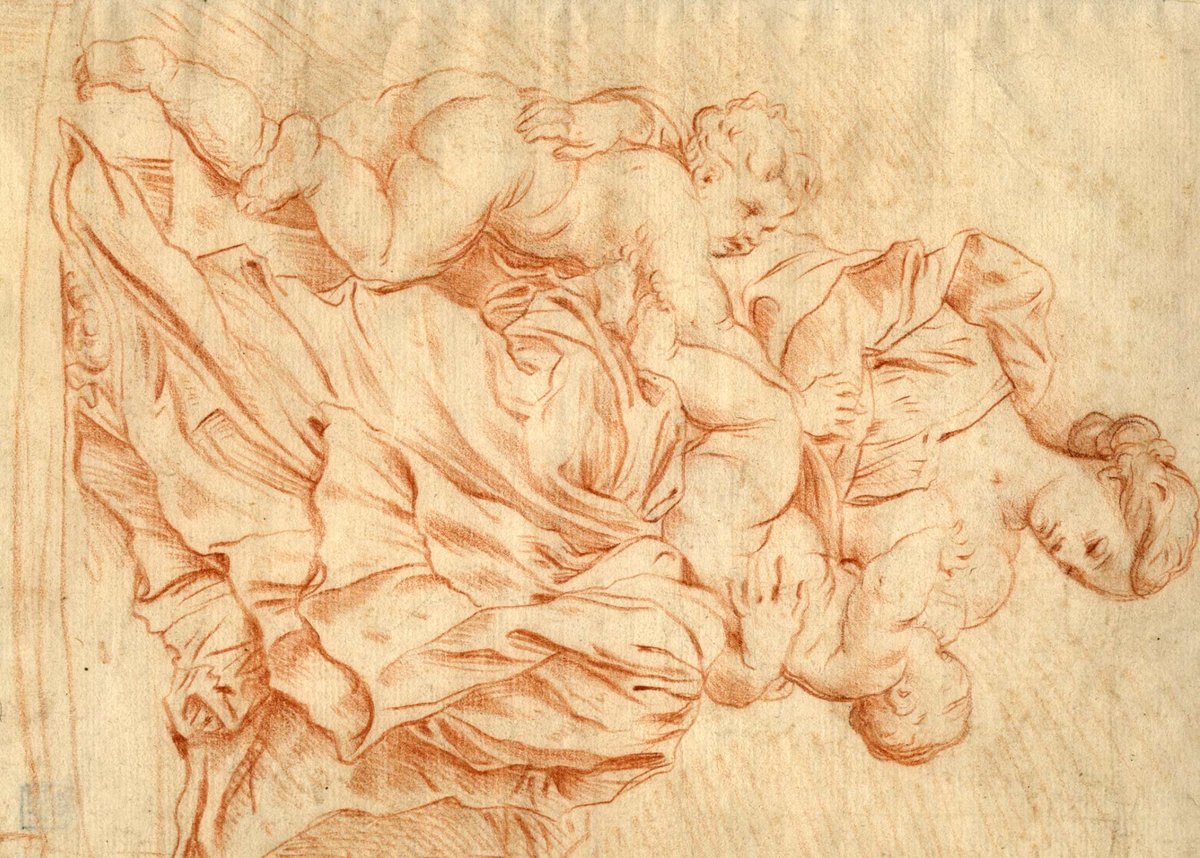The Masterpieces of Gian Lorenzo Bernini

Bernini’s body of work is vast and varied, showcasing a remarkable range of talents that establish him as a true master of the Baroque style. Each piece he created offers a glimpse into his creative genius and his ability to evoke emotion through marble and space.
The Ecstasy of Saint Teresa

One of Bernini’s most celebrated works, The Ecstasy of Saint Teresa, serves as a pinnacle of Baroque sculpture.
This masterpiece resides within the Cornaro Chapel in Santa Maria della Vittoria in Rome and depicts the mystical experience of Saint Teresa of Avila.
In this sculpture, Bernini captures the moment of divine intervention with an unparalleled sensitivity to light and form.
The angel, poised delicately above Teresa, is depicted with a piercing gaze, while the saint herself is shown in a state of rapture.
The dynamic movement of the drapery and the ethereal quality of the figures imbue the work with a sense of spiritual transcendence.
Through this intricate interplay of figures, Bernini conveys a powerful narrative that speaks to the viewer’s emotions, inviting contemplation and reflection on the nature of faith and divine love.
The Fountain of the Four Rivers
Another significant creation by Bernini is the Fountain of the Four Rivers located in Piazza Navona, Rome.
This monumental fountain celebrates the four major rivers of the four continents known at the time: the Ganges, Nile, Danube, and Rio de la Plata.
Each element of the fountain is meticulously designed to embody the characteristics of the respective rivers it represents.
From the bold posture of the river gods to the dynamic interaction with water and stone, this work exemplifies Bernini’s ability to blend sculpture with environment seamlessly.
The fountain not only serves as a functional water source but also creates a dramatic visual spectacle that brings the piazza to life, drawing visitors into its grandeur and complexity.
The Baldachin of Saint Peter’s Basilica

Within the heart of Vatican City, the Baldachin of Saint Peter’s Basilica stands as a testament to Bernini’s architectural prowess.
Commissioned to mark the tomb of Saint Peter, this grand structure made of bronze towers above the altar, creating a focal point for worshippers and pilgrims alike.
The intertwining columns adorned with rich decoration and the use of light create a celestial ambiance that elevates the spiritual experience within the basilica.
Bernini’s attention to detail and understanding of spatial dynamics are evident in how the baldachin draws visitors’ eyes upward, guiding them toward the heavens.
As both a sculpture and architectural feature, the baldachin integrates Bernini’s thematic exploration of faith with physical artistry, engaging viewers on multiple levels.
The Influence of Gian Lorenzo Bernini on Baroque Art
Gian Lorenzo Bernini didn’t merely reflect the aesthetics of the Baroque period; he defined and expanded them. His innovative techniques paved the way for future artists and shaped the direction of European art for generations.
Emotional Depth in Art

A hallmark of Bernini’s genius is his capacity to infuse emotional depth into his sculptures.
Unlike many of his predecessors, who often prioritized realism or idealized beauty, Bernini focused on the raw emotional experiences of his subjects.
Each sculpture becomes a moment frozen in time, encapsulating a wide spectrum of feelings from ecstasy to despair.
For instance, in The Rape of Proserpina, Bernini captures the moment of abduction with such intensity that viewers can almost feel the struggle and fear of Proserpina.
This emotional accessibility allows audiences to connect with the figures on a personal level, transcending the boundaries of time and culture.
Architectural Innovation

Bernini’s contributions extend beyond sculpture into architecture, where his vision transformed spaces into immersive experiences.
His design of the Piazza San Pietro is a prime example of this integration, creating a harmonious relationship between the church and its surrounding environment.
The colonnade, resembling open arms, welcomes visitors and symbolizes the embrace of the Catholic Church.
Through his architectural innovations, Bernini emphasized the experiential nature of Baroque art, encouraging viewers to engage with their surroundings in a profound manner.
His approach to architecture highlighted the interconnectedness of art, space, and spirituality, influencing countless architects and artists in the aftermath of his work.
Cultural Significance

Bernini’s influence also extends to the cultural landscape of 17th-century Italy.
He emerged during a period marked by significant religious conflict and transformation, and his artwork reflects the tension and fervor of the Counter-Reformation.
His works became tools of propaganda for the Catholic Church, communicating complex theological themes through accessible visuals.
As a cultural icon, Bernini played a pivotal role in shaping public perception and sentiment during a tumultuous era, solidifying the importance of art as a vehicle for social and political commentary.
Today, his legacy remains a vital part of art history, illustrating how creativity can influence societal norms and beliefs.
The Interplay of Sculpture and Architecture by Gian Lorenzo Bernini
Bernini’s unique ability to merge sculpture with architecture set him apart from his contemporaries, leading to an entirely new form of artistic expression.
Bridging Two Disciplines

Bernini’s work often blurs the lines between sculpture and architecture, creating environments wherein each discipline enhances the other.
In many of his projects, such as the Cathedra Petri in St. Peter’s Basilica, he designed not only the sculptural elements but also the surrounding architecture, ensuring a cohesive aesthetic.
This integration produces a holistic experience for the viewer, as they are surrounded by Bernini’s vision from all angles.
The seamless transition between the two forms invites spectators to consider the interplay of material, space, and narrative in a way that was revolutionary for its time.
The Role of Light

An essential element in Bernini’s work is his understanding of light as a medium that transforms both sculpture and architecture.
He skillfully manipulated natural and artificial light to enhance the emotional impact of his pieces.
In the Ecstasy of Saint Teresa, the clever placement of windows allows light to illuminate the central figures dramatically, accentuating their expressions and enhancing the mystical atmosphere.
By utilizing light to guide the viewer’s gaze, Bernini creates a dialogue between the art and its environment that fosters deeper engagement and contemplation.
A Lasting Legacy

Bernini’s pioneering efforts in merging sculpture and architecture have inspired countless artists and architects throughout history.
His ability to create immersive experiences continues to resonate in modern architectural practices, where the emphasis on experiential design has become increasingly important.
Contemporary artists often draw inspiration from Bernini’s work, exploring the emotional and spatial implications of their creations in similarly inventive ways.
As a result, his legacy is not confined to the Baroque era; instead, it reverberates across time, reminding us of art’s transformative power.
The Spiritual Dimension of Gian Lorenzo Bernini’s Work
At the core of Bernini’s creations lies a deep spiritual dimension, reflecting the intricate relationship between art, faith, and humanity.
Art as a Medium of Spiritual Expression

Bernini viewed art as a conduit for expressing the divine, imbuing his works with a sense of spirituality that resonates with viewers.
His sculptures often depict religious figures engaged in moments of divine revelation, inviting observers to reflect on their own spiritual journeys.
The emotional intensity present in his work encourages introspection, prompting questions about faith, existence, and the connection to the sacred.
In this way, Bernini’s art serves as both a representation of religious narratives and an invitation for personal exploration of spirituality.
The Impact of Counter-Reformation

The context of the Counter-Reformation significantly shaped Bernini’s work, as the Catholic Church sought to reaffirm its authority and inspire devotion among the faithful.
Through theatrical representations of saints and biblical events, Bernini’s art served as powerful visual sermons that communicated complex theological concepts in relatable terms.
The emotive qualities of his sculptures were instrumental in fostering a renewed sense of religious fervor during a time of significant upheaval.
As a key figure in this movement, Bernini’s work entrusted art with the responsibility of moral and spiritual guidance.
The Enduring Relevance of Bernini’s Faith

Even centuries after his death, Bernini’s exploration of spirituality continues to resonate.
His ability to intertwine personal faith with universal themes allows audiences to connect with his work on multiple levels, regardless of individual beliefs.
Whether grappling with existential questions or seeking solace in the beauty of art, viewers find themselves drawn to the heartfelt sincerity of Bernini’s creations.
In this sense, his work transcends the limitations of time and circumstance, maintaining its relevance as a touchstone for spiritual inquiry and artistic inspiration.
Conclusion
Gian Lorenzo Bernini’s contributions to art and architecture have left an indelible mark on history. His ability to weave together emotion, spirituality, and innovative design has established him as a foundational figure in the Baroque movement. Through his masterpieces, Bernini invites us to explore the depths of human experience, transcending time and cultural boundaries. As we reflect upon his legacy, we recognize not only the sublime craftsmanship of his work but also the enduring power of art to communicate profound truths about faith, emotion, and the shared human condition. In revisiting the life and creations of Gian Lorenzo Bernini, we celebrate a visionary whose influence continues to inspire and resonate in contemporary artistry.
Gian Lorenzo Bernini stands out as one of the most influential figures in art history, particularly during the Baroque era. His mastery in sculpture and architecture not only redefined artistic standards but also created a lasting impact on Western art. Born on December 7, 1598, Bernini amalgamated intricate sculptural techniques with architectural innovation, culminating in masterpieces that continue to resonate today. Through his work, Bernini explored profound emotional depths that resonated with viewers, capturing the essence of human experience.
The Masterpieces of Gian Lorenzo Bernini

Bernini’s body of work is vast and varied, showcasing a remarkable range of talents that establish him as a true master of the Baroque style. Each piece he created offers a glimpse into his creative genius and his ability to evoke emotion through marble and space.
The Ecstasy of Saint Teresa

One of Bernini’s most celebrated works, The Ecstasy of Saint Teresa, serves as a pinnacle of Baroque sculpture.
This masterpiece resides within the Cornaro Chapel in Santa Maria della Vittoria in Rome and depicts the mystical experience of Saint Teresa of Avila.
In this sculpture, Bernini captures the moment of divine intervention with an unparalleled sensitivity to light and form.
The angel, poised delicately above Teresa, is depicted with a piercing gaze, while the saint herself is shown in a state of rapture.
The dynamic movement of the drapery and the ethereal quality of the figures imbue the work with a sense of spiritual transcendence.
Through this intricate interplay of figures, Bernini conveys a powerful narrative that speaks to the viewer’s emotions, inviting contemplation and reflection on the nature of faith and divine love.
The Fountain of the Four Rivers

Another significant creation by Bernini is the Fountain of the Four Rivers located in Piazza Navona, Rome.
This monumental fountain celebrates the four major rivers of the four continents known at the time: the Ganges, Nile, Danube, and Rio de la Plata.
Each element of the fountain is meticulously designed to embody the characteristics of the respective rivers it represents.
From the bold posture of the river gods to the dynamic interaction with water and stone, this work exemplifies Bernini’s ability to blend sculpture with environment seamlessly.
The fountain not only serves as a functional water source but also creates a dramatic visual spectacle that brings the piazza to life, drawing visitors into its grandeur and complexity.
The Baldachin of Saint Peter’s Basilica

Within the heart of Vatican City, the Baldachin of Saint Peter’s Basilica stands as a testament to Bernini’s architectural prowess.
Commissioned to mark the tomb of Saint Peter, this grand structure made of bronze towers above the altar, creating a focal point for worshippers and pilgrims alike.
The intertwining columns adorned with rich decoration and the use of light create a celestial ambiance that elevates the spiritual experience within the basilica.
Bernini’s attention to detail and understanding of spatial dynamics are evident in how the baldachin draws visitors’ eyes upward, guiding them toward the heavens.
As both a sculpture and architectural feature, the baldachin integrates Bernini’s thematic exploration of faith with physical artistry, engaging viewers on multiple levels.
The Influence of Gian Lorenzo Bernini on Baroque Art

Gian Lorenzo Bernini didn’t merely reflect the aesthetics of the Baroque period; he defined and expanded them. His innovative techniques paved the way for future artists and shaped the direction of European art for generations.
Emotional Depth in Art

A hallmark of Bernini’s genius is his capacity to infuse emotional depth into his sculptures.
Unlike many of his predecessors, who often prioritized realism or idealized beauty, Bernini focused on the raw emotional experiences of his subjects.
Each sculpture becomes a moment frozen in time, encapsulating a wide spectrum of feelings from ecstasy to despair.
For instance, in The Rape of Proserpina, Bernini captures the moment of abduction with such intensity that viewers can almost feel the struggle and fear of Proserpina.
This emotional accessibility allows audiences to connect with the figures on a personal level, transcending the boundaries of time and culture.
Architectural Innovation

Bernini’s contributions extend beyond sculpture into architecture, where his vision transformed spaces into immersive experiences.
His design of the Piazza San Pietro is a prime example of this integration, creating a harmonious relationship between the church and its surrounding environment.
The colonnade, resembling open arms, welcomes visitors and symbolizes the embrace of the Catholic Church.
Through his architectural innovations, Bernini emphasized the experiential nature of Baroque art, encouraging viewers to engage with their surroundings in a profound manner.
His approach to architecture highlighted the interconnectedness of art, space, and spirituality, influencing countless architects and artists in the aftermath of his work.
Cultural Significance

Bernini’s influence also extends to the cultural landscape of 17th-century Italy.
He emerged during a period marked by significant religious conflict and transformation, and his artwork reflects the tension and fervor of the Counter-Reformation.
His works became tools of propaganda for the Catholic Church, communicating complex theological themes through accessible visuals.
As a cultural icon, Bernini played a pivotal role in shaping public perception and sentiment during a tumultuous era, solidifying the importance of art as a vehicle for social and political commentary.
Today, his legacy remains a vital part of art history, illustrating how creativity can influence societal norms and beliefs.
The Interplay of Sculpture and Architecture by Gian Lorenzo Bernini
Bernini’s unique ability to merge sculpture with architecture set him apart from his contemporaries, leading to an entirely new form of artistic expression.
Bridging Two Disciplines

Bernini’s work often blurs the lines between sculpture and architecture, creating environments wherein each discipline enhances the other.
In many of his projects, such as the Cathedra Petri in St. Peter’s Basilica, he designed not only the sculptural elements but also the surrounding architecture, ensuring a cohesive aesthetic.
This integration produces a holistic experience for the viewer, as they are surrounded by Bernini’s vision from all angles.
The seamless transition between the two forms invites spectators to consider the interplay of material, space, and narrative in a way that was revolutionary for its time.
The Role of Light

An essential element in Bernini’s work is his understanding of light as a medium that transforms both sculpture and architecture.
He skillfully manipulated natural and artificial light to enhance the emotional impact of his pieces.
In the Ecstasy of Saint Teresa, the clever placement of windows allows light to illuminate the central figures dramatically, accentuating their expressions and enhancing the mystical atmosphere.
By utilizing light to guide the viewer’s gaze, Bernini creates a dialogue between the art and its environment that fosters deeper engagement and contemplation.
A Lasting Legacy

Bernini’s pioneering efforts in merging sculpture and architecture have inspired countless artists and architects throughout history.
His ability to create immersive experiences continues to resonate in modern architectural practices, where the emphasis on experiential design has become increasingly important.
Contemporary artists often draw inspiration from Bernini’s work, exploring the emotional and spatial implications of their creations in similarly inventive ways.
As a result, his legacy is not confined to the Baroque era; instead, it reverberates across time, reminding us of art’s transformative power.
The Spiritual Dimension of Gian Lorenzo Bernini’s Work

At the core of Bernini’s creations lies a deep spiritual dimension, reflecting the intricate relationship between art, faith, and humanity.
Art as a Medium of Spiritual Expression

Bernini viewed art as a conduit for expressing the divine, imbuing his works with a sense of spirituality that resonates with viewers.
His sculptures often depict religious figures engaged in moments of divine revelation, inviting observers to reflect on their own spiritual journeys.
The emotional intensity present in his work encourages introspection, prompting questions about faith, existence, and the connection to the sacred.
In this way, Bernini’s art serves as both a representation of religious narratives and an invitation for personal exploration of spirituality.
The Impact of Counter-Reformation

The context of the Counter-Reformation significantly shaped Bernini’s work, as the Catholic Church sought to reaffirm its authority and inspire devotion among the faithful.
Through theatrical representations of saints and biblical events, Bernini’s art served as powerful visual sermons that communicated complex theological concepts in relatable terms.
The emotive qualities of his sculptures were instrumental in fostering a renewed sense of religious fervor during a time of significant upheaval.
As a key figure in this movement, Bernini’s work entrusted art with the responsibility of moral and spiritual guidance.
The Enduring Relevance of Bernini’s Faith

Even centuries after his death, Bernini’s exploration of spirituality continues to resonate.
His ability to intertwine personal faith with universal themes allows audiences to connect with his work on multiple levels, regardless of individual beliefs.
Whether grappling with existential questions or seeking solace in the beauty of art, viewers find themselves drawn to the heartfelt sincerity of Bernini’s creations.
In this sense, his work transcends the limitations of time and circumstance, maintaining its relevance as a touchstone for spiritual inquiry and artistic inspiration.
Conclusion

Gian Lorenzo Bernini’s contributions to art and architecture have left an indelible mark on history. His ability to weave together emotion, spirituality, and innovative design has established him as a foundational figure in the Baroque movement. Through his masterpieces, Bernini invites us to explore the depths of human experience, transcending time and cultural boundaries. As we reflect upon his legacy, we recognize not only the sublime craftsmanship of his work but also the enduring power of art to communicate profound truths about faith, emotion, and the shared human condition. In revisiting the life and creations of Gian Lorenzo Bernini, we celebrate a visionary whose influence continues to inspire and resonate in contemporary artistry.
✉️ Stay Connected — Subscribe for Weekly Updates
Discover timeless stories, practical wisdom, and beautiful culture — delivered straight to your inbox.
*We only share valuable insights — no spam, ever.






